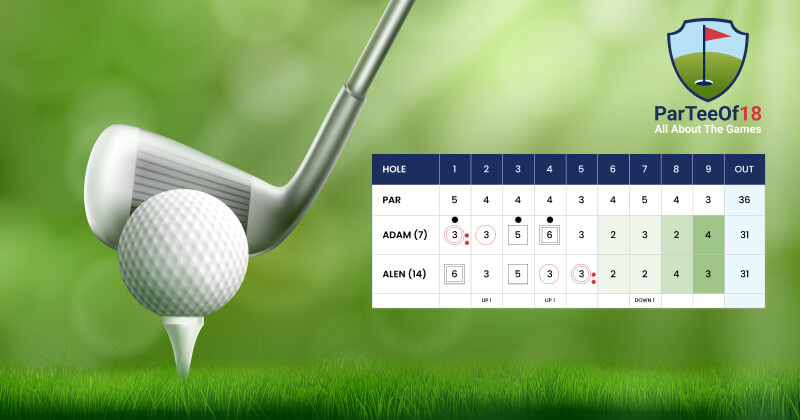Golf is a precision sport, and understanding the layout of the green can make a significant difference. This is where golf green maps can help. Golf course maps allow players to read the slopes, breaks, and shape of the green, improving their understanding of the game. However, with recent advancements in golf technology, more facilities are now providing golfers with the opportunity to use 3D green heat maps to get even better. To assist you in that, we will go over how golf green maps work and why their use is essential for beginners and professionals alike.
The 3D green heat map is a next-level upgrade of the traditional golf green map and provides detailed information about the slopes/breaks in the green using color codes and elevations of the green.
These advanced maps give golfers an additional and smarter way to read and understand the movement of a ball and strike a golf shot with confidence. Adding 3D green heat maps to traditional golf green maps allows players to visualize the course better than ever and improve on each and every hole. Keep reading this guide to know more about the golf green maps and their advantages with real-world examples.
Understanding Golf Green Maps
Modern golf green maps are digital blueprints of putting surfaces. They show detailed slopes, contours, and subtle undulations influencing ball roll. Using drone and LiDAR technology, every inch of turf is scanned and converted into an interactive visual model.
Players use these to read breaks more accurately, while course managers rely on them to maintain uniform playing conditions. For instance, green maps golf can highlight high spots that dry out faster or low areas prone to pooling water. These visuals give everyone—from tour professionals to groundskeepers—a shared, data-backed view of each hole’s complexity.
A golf green map also plays a crucial role in design and renovation. Architects use them to plan drainage, manage slopes, and ensure fair playability. Over time, these maps evolve, integrating live data to form dynamic golf course green maps that support ongoing turf monitoring.
What Are 3D Green Heat Maps?
A 3D green heat map adds color-coded visualization to traditional mapping. Each hue represents slope intensity or elevation—red for steep gradients, blue for flatter zones, and green or yellow for moderate transitions.
This helps players quickly identify where putts will pick up or lose speed. For course managers, heat zones highlight stress areas, showing which parts dry faster or retain too much moisture. Integrating this with golf green maps gives a complete view of playability and maintenance needs.
Understanding how to read a golf green heat map means interpreting those colors as movement cues. Warm zones often indicate faster ball speed; cooler tones suggest gentler breaks. It’s a visual language that transforms green reading from guesswork into science.
Integrating 3D Green Heat Maps with Golf Green Maps
The combination of 3D green heat maps with golf green maps marks a major step forward in modern golf course analytics. By blending traditional slope and contour data with high-resolution 3D visuals, players, course managers, and designers can better understand how each green behaves under real conditions. This integration doesn’t just enhance visibility—it transforms decision-making, play strategy, and turf maintenance into a data-driven experience.
Enhanced Visualization
When 3D green heat maps are layered over golf green maps, every elevation change, slope angle, and contour becomes instantly visible. The color-coded representation helps users intuitively understand how steep or flat different sections are, offering a clearer perspective than standard contour lines ever could.
Smart Course Management
Maintenance teams benefit greatly from this integration. By reading color heat variations, they can identify areas that retain water, dry out quickly, or experience excessive foot traffic. This enables targeted aeration, irrigation, and fertilization, ensuring consistent green speed and healthier turf.
Improved Player Strategy
Golfers can use the enhanced data to visualize how their putts will roll. The combined maps reveal subtle breaks that might be invisible to the naked eye, helping players adjust their aim and pace. Learning how to read putting green heat map visuals in conjunction with slope arrows gives golfers a competitive advantage.
Data Integration and Precision
The process involves merging multiple technologies—LiDAR, drone imagery, and GPS mapping—into a single system. This ensures that the golf green map accurately reflects real-time topography. The result is a digital model that mirrors the physical green to near perfection.
Design and Layout Optimization
For architects, integrating 3D green heat data into golf course green maps offers deeper insight during the planning phase. It allows them to test design concepts virtually, visualize water flow, and maintain fairness while preserving challenge. This balance enhances both player satisfaction and course longevity.
Benefits of 3D Green Heat Map Integration
Integrating 3D green heat maps with golf green maps revolutionizes how golfers, designers, and course managers view and manage putting surfaces. This combination turns static visuals into living data systems that enhance playability, precision, and turf health while helping players interpret each green’s behavior with confidence and clarity.
Better Green Visualization
3D heat maps transform complex slope data into clear, color-coded visuals layered over golf green maps. Each hue represents elevation or gradient, allowing golfers and managers to instantly recognize steep areas, subtle undulations, or flatter zones. This visual clarity removes guesswork, helping players make better reads and course staff plan maintenance more accurately.
Data-Driven Course Management
By combining golf green maps with live sensor or drone data, superintendents gain valuable insight into moisture balance, soil compaction, and water runoff patterns. This integration supports smarter irrigation and mowing schedules, ensuring that turf remains consistent and healthy. It reduces water waste, minimizes wear, and delivers smoother greens for daily play.
Improved Player Performance
For golfers, these maps are more than visuals—they’re strategic tools. By learning how to read putting green heat map data, players can predict ball roll, speed, and break direction. The visual cues help golfers adapt to changing green conditions, improve putting accuracy, and approach each shot with enhanced confidence and understanding.
Predictive Maintenance
3D green heat maps provide early warnings of stress-prone zones. Areas that appear overly “hot” on the map may indicate slope-driven water loss, while “cool” zones might trap excess moisture. By analyzing these heat patterns, maintenance teams can act proactively—adjusting watering, aeration, or mowing practices to maintain even turf quality.
Enhanced Course Design
Course architects use integrated golf course green maps during design or renovation to model surface flow, slope transitions, and playability. With 3D data, they can visualize how greens will perform under different weather or traffic conditions. This helps them create balanced, fair, and aesthetically appealing greens that challenge players while ensuring long-term durability.
How to Read a Golf Green Heat Map
Understanding how to read a golf green heat map is a skill that can instantly elevate your putting performance. These maps visualize slopes, contours, and speed variations using color gradients. By learning to interpret these shades and symbols, golfers can predict ball behavior more accurately and make confident, data-informed putting decisions.
Recognize Color Patterns
Each color on the heat map represents slope intensity or elevation. Red or orange zones indicate steeper areas or faster rolls, while blue and green tones mark flatter, slower regions. By quickly recognizing these hues, players can estimate how gravity will influence the ball’s direction and adjust their aim accordingly.
Study Contour Lines and Arrows
Alongside color coding, contour lines and arrows show slope direction and gradient flow. The tighter the lines, the steeper the slope. When used with golf green maps, these directional cues guide golfers on where a putt might break and how much speed to apply for consistent roll across the green.
Combine Heat Data with Real Observation
Reading a heat map isn’t just digital analysis—it’s about merging visuals with on-course observation. Stand behind your line, match what you see to the heat zones, and visualize the break path. This connection between visual data and real feel helps golfers interpret greens more naturally and confidently.
Identify High-Speed and Slow Zones
By observing red or yellow zones, golfers can pinpoint faster-rolling areas that require a softer touch. Conversely, blue or green sections signal slower spots that need extra pace. Understanding these zones allows players to adapt their stroke speed effectively and maintain accuracy on different green textures.
Practice Consistent Reading
Learning how to read putting green heat map visuals consistently takes repetition. The more golfers practice aligning colors, contours, and ball behavior, the sharper their instincts become. Over time, this data-driven reading habit turns into intuition, helping players make quicker, more accurate judgments during real play.
Real-World Applications and Case Studies
The integration of 3D green heat maps with golf green maps isn’t just theory—it’s transforming real courses worldwide. From professional tournaments to everyday course management, this technology delivers measurable results, helping players, designers, and superintendents improve performance, precision, and playability across all levels of the game.
Tournament Course Preparation
Elite golf events now rely on 3D heat-integrated golf green maps to ensure consistent playing conditions. Course managers use these maps to monitor slope uniformity, moisture balance, and green speed, allowing precise adjustments before tournaments. This creates a level, fair environment for all competitors while maintaining optimal turf health throughout the event.
Player Performance Analytics
Professional golfers analyze putting performance using green maps golf data combined with 3D heat overlays. These visuals reveal tendencies in shot direction, speed control, and break misreads. Coaches then use this data to tailor practice sessions, helping players improve accuracy, confidence, and decision-making on complex greens.
Course Maintenance Optimization
Superintendents use integrated golf green maps to manage irrigation and mowing with data precision. Heat maps identify stress zones and water distribution patterns, guiding proactive maintenance. By addressing issues early, courses reduce water usage, prevent turf degradation, and deliver smoother greens for both professionals and amateurs alike.
Design and Renovation Projects
Course architects incorporate 3D green heat maps into golf course green maps during design updates. By visualizing real slope data, they can refine green contours and drainage systems before construction begins. This results in more balanced designs that challenge skilled players while remaining enjoyable for all skill levels.
Amateur Golf Training Apps
Modern golf apps now integrate simplified golf green map heat visuals, bringing pro-level analysis to casual players. These tools teach golfers how to read putting green heat map data, helping them understand contours and improve accuracy. With accessible technology, everyday golfers can now make smarter, data-based decisions on every green.
The Future of Golf Green Mapping
The future of golf green maps lies in the fusion of advanced technology and sustainability. As innovation accelerates, tools like AI, augmented reality, and smart sensors will redefine how players interact with greens, how superintendents maintain them, and how designers create courses that are both challenging and environmentally efficient.
AI-Powered Predictive Insights
Artificial intelligence will soon analyze thousands of rounds and environmental factors to forecast turf performance. By combining 3D heat data with machine learning, golf green maps will predict ball behavior, moisture changes, and wear patterns, allowing both golfers and course managers to make data-driven decisions faster than ever before.
Augmented Reality (AR) Green Reading
AR will revolutionize green reading by projecting live overlays onto greens through smart glasses or mobile apps. Golfers will instantly see slope direction, elevation, and break paths from golf green map data, turning practice and play into immersive, interactive experiences without disrupting the game’s natural flow.
Smart Sensor Integration
Future courses will integrate IoT sensors beneath greens to monitor soil temperature, moisture, and firmness. This live data will sync with green maps golf, creating continuously updated 3D visuals. Superintendents will receive instant alerts for problem areas, ensuring consistent speed and optimal playing conditions year-round.
Sustainable Course Management
With growing environmental awareness, 3D mapping will help create more sustainable golf course green maps. Predictive models will optimize irrigation, reducing water usage and chemical dependency. This eco-smart approach ensures healthier greens and aligns with global efforts toward environmentally responsible course maintenance.
Virtual and Remote Course Simulation
Golfers and designers will soon use virtual reality to explore greens remotely. These 3D simulations, built from golf green maps and heat data, allow players to study contours before arriving on-site and help architects design playable layouts digitally — saving time, resources, and environmental impact.
Conclusion
The integration of 3D green heat maps with golf green maps marks a new era in golf course intelligence. From precision slope analysis to advanced data visualization, this technology enhances how players read greens, how course managers maintain turf, and how designers create balanced, performance-driven layouts.
By learning how to read putting green heat map visuals and combining them with traditional green mapping, golfers gain a strategic edge, improving accuracy and confidence on every putt. For course management, the benefits extend beyond play — it’s about sustainability, consistency, and smarter use of resources.
Innovative platforms like ParTeeOf18 are driving this evolution forward by combining scoring, analytics, and 3D mapping into one seamless experience. As a smart golf scoring app with an integrated 3D green heat map feature, ParTeeOf18 helps players visualize greens in detail, improve putting decisions, and track performance more intelligently. Together, these innovations are shaping a smarter, data-driven future for golf.
FAQs
What are golf green maps?
Golf green maps show slopes, contours, and elevation details of putting surfaces. They help golfers plan accurate putts, course managers maintain consistent greens, and designers create balanced, playable layouts.
How do 3D green heat maps improve golf green maps?
3D heat maps use color gradients to display slope and elevation intensity. When merged with golf green maps, they give golfers clearer visuals, help managers identify turf issues, and guide smarter course design.
How to read putting green heat map visuals?
To read putting green heat map visuals, focus on colors — red means steeper or faster areas, while blue or green shows flatter, slower zones. Matching these visuals with on-course observation improves putting accuracy.
Why are 3D green heat maps important for modern golf?
3D heat mapping adds a new level of insight to traditional golf green maps. It helps golfers read greens more precisely, supports predictive turf management, and allows designers to optimize playability and sustainability in modern golf course layouts.




